Architecture Home Styles
10 Surprising Benefits of Adobe Walls for Your Home
Fascinating benefits of adobe walls await, offering more than meets the eye for your home sanctuary.
Imagine a home where the gentle warmth of the sun seeps through the walls, creating a cozy sanctuary in the midst of a chilly winter day. The benefits of adobe walls extend far beyond their earthy appearance.
From surprising advantages like natural soundproofing to eco-friendly construction, these walls offer a multitude of benefits that might just transform the way you view traditional building materials.
Let's explore how adobe walls can elevate your living experience and bring unexpected perks to your home.
Key Takeaways
- Energy Efficiency: Adobe walls excel at regulating indoor temperatures, reducing energy consumption, and enhancing comfort year-round.
- Environmental Sustainability: Choosing adobe promotes eco-friendly practices, reduces carbon emissions, and supports sustainable construction methods.
- Safety and Durability: Adobe walls offer natural pest resistance, fire protection, and durability against harsh elements for long-lasting safety.
- Health Benefits: Maintain indoor air quality, regulate humidity levels, and prevent mold growth, promoting a healthier living environment.
Enhanced Thermal Regulation
Adobe walls excel at maintaining indoor comfort through their exceptional thermal properties, serving as a sustainable and energy-efficient solution for regulating temperatures in homes. The aesthetic appeal of adobe construction is coupled with its practical benefits. By absorbing heat during the day and releasing it at night, adobe walls help create a stable and comfortable environment inside the house. This natural thermal mass reduces the reliance on heating and cooling systems, leading to energy savings and lower utility bills.
In warmer climates, adobe walls act as a barrier against external heat, keeping interiors cool by impeding the transfer of warmth. Conversely, in colder regions, these walls retain heat effectively, ensuring that the interior remains warm and cozy without excessive energy usage. The thermal regulation provided by adobe walls not only enhances the comfort of living spaces but also contributes to overall energy efficiency. This combination of functionality and visual appeal makes adobe walls a smart choice for environmentally-conscious homeowners seeking innovative solutions for their living spaces.
Natural Soundproofing Qualities
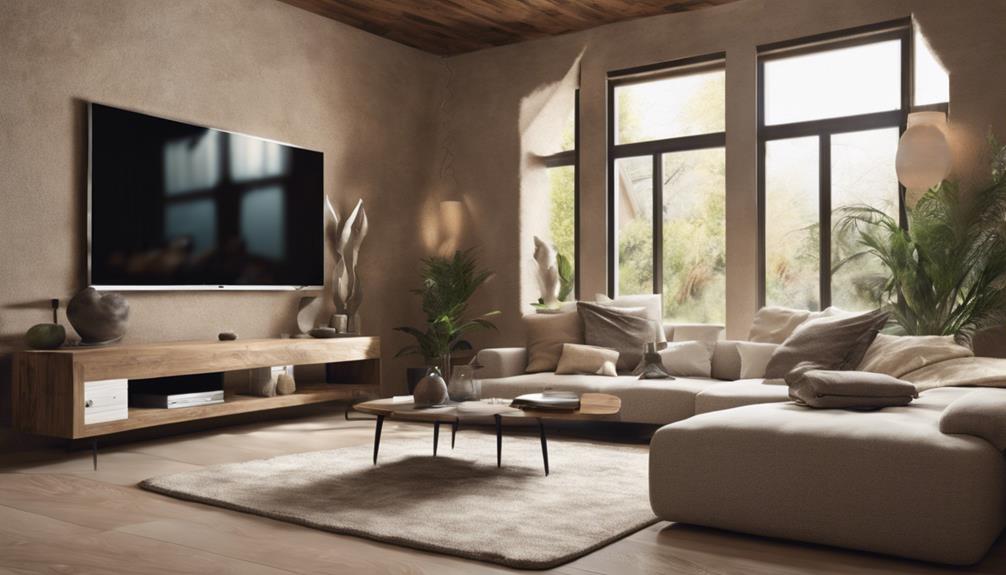
Enhancing the acoustic environment within a home, the density and composition of adobe walls naturally lend themselves to soundproofing qualities. The thick mud walls act as a barrier, effectively absorbing and dampening sound waves, which significantly reduces noise transmission between rooms. This feature not only creates a quieter indoor space but also fosters a more peaceful atmosphere, perfect for enhancing privacy and relaxation.
Additionally, adobe walls excel at blocking out external noises, such as traffic or neighbors, thereby improving the overall acoustic comfort of the home. The natural soundproofing properties of adobe walls contribute to a serene and tranquil living environment, allowing occupants to escape the hustle and bustle of the outside world.
Incorporating adobe walls into your home design not only offers eco-friendly benefits but also ensures a more acoustically pleasing living space where tranquility reigns supreme.
Eco-Friendly Construction Material
Utilizing sustainable materials in construction projects is a crucial step towards reducing environmental impact and promoting eco-conscious practices. Adobe walls, composed of earth, clay, sand, and sometimes straw, offer a sustainable and eco-friendly construction solution. Unlike traditional materials such as cement or steel, the production of adobe bricks requires minimal energy and emits significantly less carbon dioxide. Furthermore, adobe walls possess exceptional thermal mass properties, naturally moderating indoor temperatures and lessening the reliance on artificial heating or cooling systems.
One of the key environmental benefits of adobe construction is its contribution to reducing landfill waste. Being biodegradable, adobe can be recycled back into the environment without polluting it. By opting for adobe walls in your home, you actively support environmentally friendly practices and decrease your carbon footprint. Embracing adobe as a construction material not only offers structural integrity but also aligns with sustainable living principles, making it a wise choice for eco-conscious individuals seeking innovative solutions.
Increased Energy Efficiency
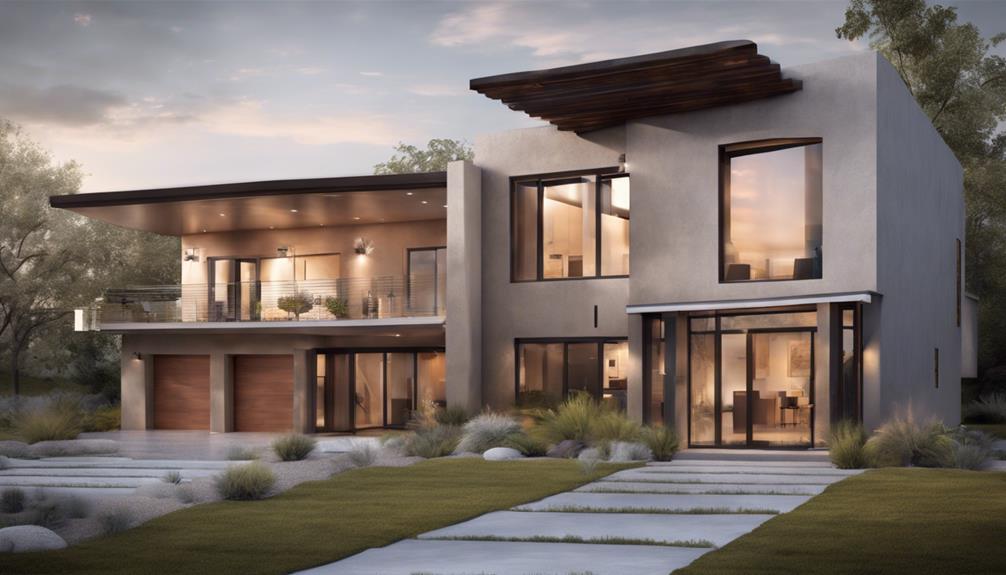
With its exceptional thermal mass properties, adobe walls effectively regulate indoor temperatures, reducing the reliance on artificial heating or cooling systems. The ability of adobe walls to absorb heat during the day and slowly release it at night helps maintain a comfortable environment indoors without the need for constant adjustments to the thermostat. This high thermal inertia not only leads to energy savings but also contributes to a more sustainable lifestyle by decreasing carbon emissions associated with excessive energy consumption.
Furthermore, the natural insulation provided by adobe walls offers year-round benefits, keeping homes cooler in the summer and warmer in the winter. By choosing adobe as a construction material, homeowners can enjoy a more energy-efficient dwelling that aligns with eco-conscious values. Embracing the energy efficiency of adobe walls not only reduces utility costs but also promotes a greener approach to residential living, making it a smart choice for those seeking innovative solutions for their homes.
Pest and Fire Resistance
Adobe walls offer remarkable benefits when it comes to pest and fire resistance. Their dense composition naturally deters pests while providing excellent protection against flames and heat.
The fireproof nature of adobe walls enhances home safety, making them a reliable choice for areas prone to wildfires.
Pest Deterrent Properties
In constructing homes, one can benefit greatly from adobe walls due to their natural resistance to pests and their impressive fire deterrent properties. Adobe walls, being made of compacted earth material, naturally repel pests like termites due to their unappealing composition. The density of adobe walls acts as a strong barrier against pest penetration, reducing the risk of infestations.
Moreover, these walls offer inherent fire resistance, making them a secure choice for homes located in fire-prone areas. The solid construction of adobe walls and their thermal mass contribute to slowing down the spread of fire, providing crucial protection to both the structure and its inhabitants.
Opting for adobe walls not only effectively deters pests but also enhances the overall safety and durability of your home.
Fireproof Building Material
Utilizing adobe walls as a fireproof building material provides homeowners with a natural and effective defense against both pests and potential fire hazards. Adobe walls offer exceptional fire resistance due to their high clay content, making them a reliable choice for protecting homes from flames and heat. Here are five key benefits of using adobe walls as a fireproof building material:
- Natural Fireproofing: Adobe walls are naturally fireproof, providing excellent protection against flames.
- Pest Barrier: The thick adobe walls act as a barrier against pests like termites, preventing infestations.
- Durability: With proper maintenance, adobe walls can withstand extreme temperatures, ensuring long-lasting durability.
- Safety in Fire-Prone Areas: Adobe walls reduce the risk of structural damage during wildfires, making them ideal for fire-prone regions.
- Peace of Mind: Adobe walls offer a secure and stable structure, providing homeowners with peace of mind against fire hazards and pest threats.
Enhanced Home Safety
Enhancing home safety with a focus on pest and fire resistance involves strategic planning and implementation of effective building materials and techniques.
Adobe walls, with their high thermal mass, act as a natural barrier against fires by slowing down flame spread. Additionally, the density of adobe walls makes them unappealing to pests like termites and rodents, providing a protective shield for your home.
The natural composition of adobe, typically clay, sand, and straw, not only boosts durability but also ensures non-toxic and eco-friendly living spaces. By incorporating adobe walls into your home design, you not only enhance safety and security but also gain long-lasting protection against various threats, offering peace of mind to homeowners seeking innovative solutions for a safer living environment.
Historical and Cultural Appeal
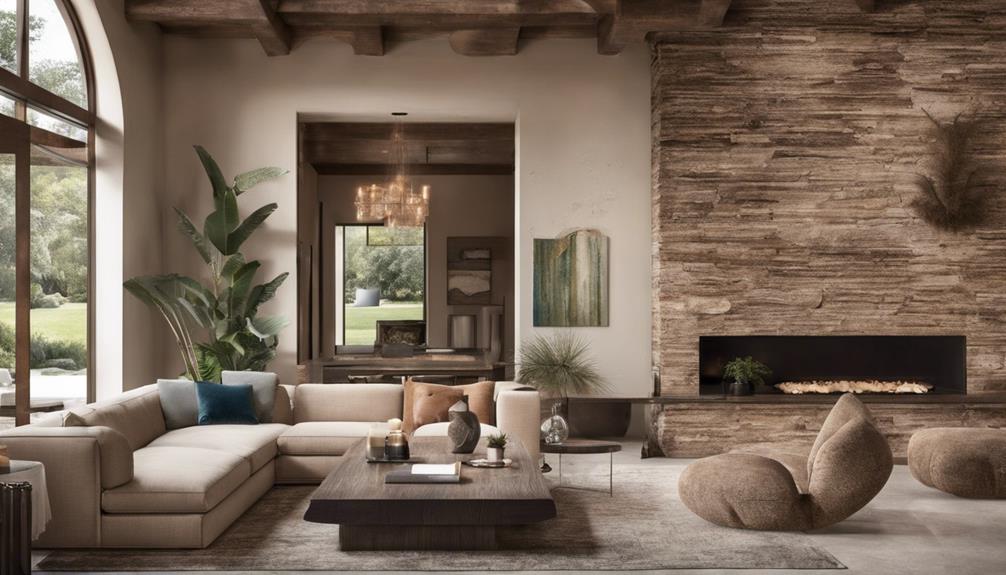
With a history spanning ancient civilizations and a global presence in traditional architecture, adobe walls stand as enduring testaments to the cultural and historical heritage of communities worldwide. These walls not only showcase the craftsmanship and design aesthetics of different regions but also highlight the sustainable practices and deep connection to the land in indigenous communities.
Here are five reasons why the historical and cultural appeal of adobe walls is so significant:
- Rich Historical Significance: Dating back thousands of years to civilizations like the Egyptians, Mesopotamians, and Incas.
- Integral Part of Many Cultures: Showcasing traditional building techniques and architectural styles worldwide.
- Reflection of Cultural Heritage: Preserving local craftsmanship and design aesthetics unique to each region.
- Emphasis on Sustainability: Highlighting sustainable practices and a strong connection to the environment.
- Blend of History and Contemporary Design: Adding a unique charm and character that appeals to modern architects and homeowners alike.
Low Maintenance Requirements
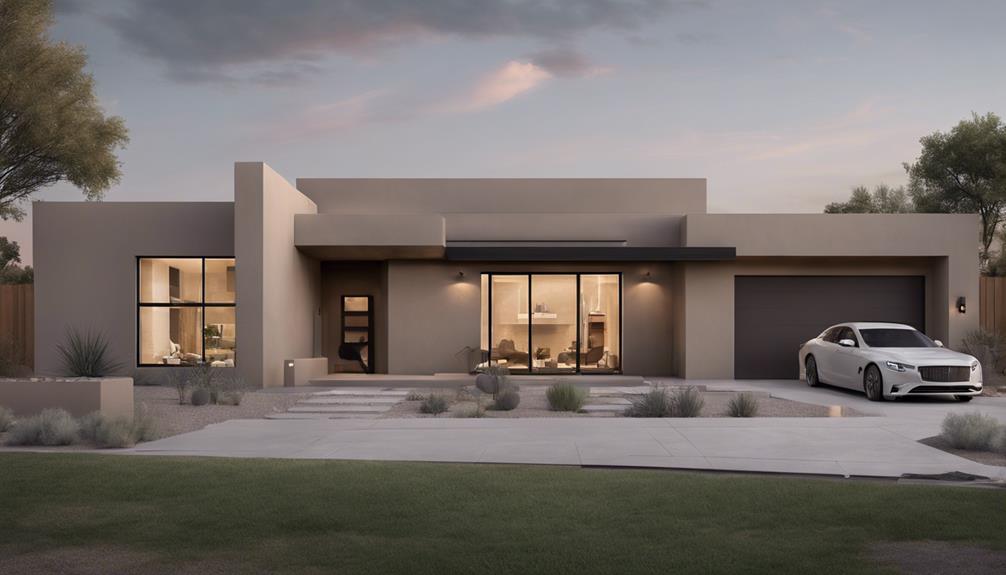
When it comes to maintaining adobe walls, we find that they require minimal effort on our part. The durable nature of the materials used in adobe construction means that we can enjoy long-lasting walls without constant repairs.
A simple cleaning routine and occasional resealing are all it takes to keep our adobe walls looking great and standing strong for years to come.
Easy Cleaning Process
Maintaining adobe walls is a breeze due to their smooth surface that requires only a damp cloth or mild soap and water for easy cleaning. The natural composition of adobe walls resists dust and dirt accumulation, reducing the need for frequent cleaning. Here are some tips to keep your adobe walls looking pristine with minimal effort:
- Wipe down the walls regularly with a damp cloth to remove any surface dust.
- For tougher stains, use a mild soap solution to gently scrub the affected area.
- Avoid harsh chemical cleaners that can damage the adobe surface.
- Consider applying a protective sealant to make cleaning even easier and enhance durability.
- Enjoy a hassle-free cleaning process that saves you time and effort, thanks to the low maintenance requirements of adobe walls.
Durable and Long-Lasting
The exceptional durability of adobe walls, due to their natural composition and solid structure, makes them a long-lasting and low-maintenance choice for homeowners. Adobe walls can last for centuries with minimal maintenance, reducing the need for frequent repairs or replacements. The natural composition and solid structure of adobe provide exceptional durability against weathering and wear. Low maintenance requirements of adobe walls save both time and money over the long term for homeowners. Properly constructed adobe walls can withstand seismic activity and other natural forces, maintaining their integrity. The longevity of adobe walls ensures a stable and reliable housing structure for generations to come.
| Benefits of Adobe Walls |
|---|
| Lasting Durability |
| Minimal Maintenance |
| Cost-Effective |
Improved Indoor Air Quality
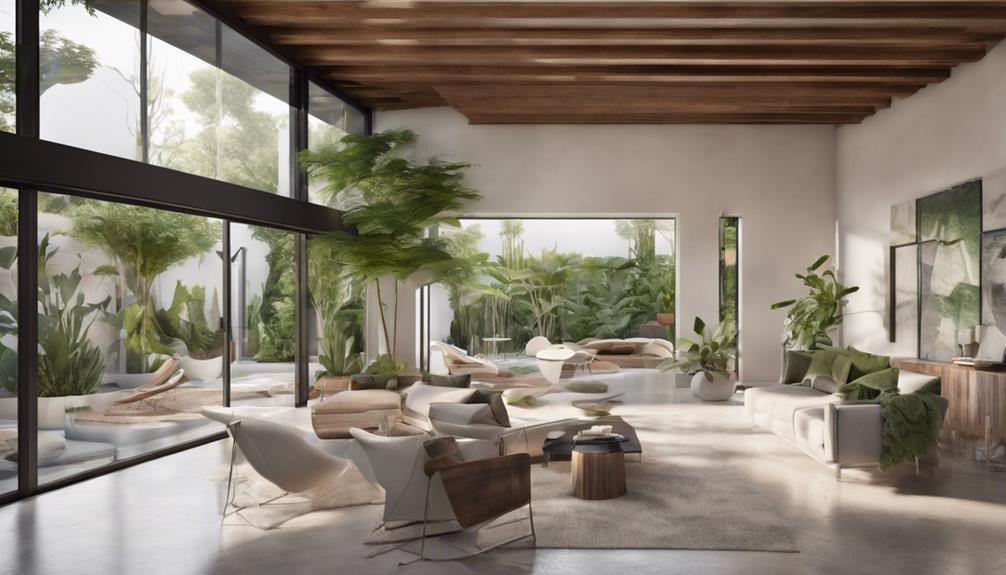
Indoors, one can experience a notable enhancement in air quality through the use of adobe walls due to their unique properties. Adobe walls offer a range of benefits that contribute to improved indoor air quality:
- Regulation of Humidity Levels: Adobe walls naturally regulate indoor humidity levels, creating a healthier living environment.
- Mold and Mildew Prevention: The porous nature of adobe walls helps to absorb and release moisture, reducing mold and mildew growth.
- Non-Toxic Material: Adobe walls don't emit harmful chemicals or off-gas like some synthetic building materials, promoting better indoor air quality.
- Temperature Stability: The thermal mass of adobe walls helps to stabilize indoor temperatures, reducing the need for heating or cooling systems.
- Comfort and Sustainability: By improving indoor air quality, adobe walls contribute to a more comfortable and sustainable living space.
These properties make adobe walls a practical and innovative choice for those seeking to enhance their indoor environment while embracing a sustainable lifestyle.
Durability and Longevity

Adobe walls exhibit remarkable durability and longevity, standing strong for centuries with minimal upkeep. Their resistance to the elements, such as rain and extreme temperatures, ensures a reliable structure that requires low maintenance costs over time.
The compressive strength of adobe walls underscores their ability to endure significant loads, making them a practical choice for long-lasting constructions.
Strong and Sturdy
When considering the durability and longevity of adobe walls, what makes them stand out from other building materials? Adobe walls have a remarkable strength and sturdiness that set them apart in the realm of construction. Here are five key factors that contribute to their robust nature:
- Exceptional Durability: Adobe walls can last for centuries with proper care.
- Weather Resistance: They withstand heavy rains, extreme heat, and seismic activity.
- Natural Composition: The combination of clay, sand, and straw creates a solid structure.
- Historical Endurance: Adobe walls have proven to outlast many modern materials.
- Low Maintenance: Minimal upkeep and repair ensure their longevity and cost-effectiveness.
Resistant to Elements
Our study reveals the remarkable capacity of adobe walls to endure the harshest elements, showcasing their exceptional durability and longevity. These walls have a proven track record of lasting for centuries, far surpassing the lifespan of many modern construction materials.
Their natural resistance to fire makes them a secure choice for homes in wildfire-prone areas, providing peace of mind to homeowners. Additionally, adobe walls can withstand extreme weather conditions, from high winds to heavy rains, due to their solid construction.
The thermal mass of adobe walls also plays a key role in regulating indoor temperatures, reducing the reliance on heating and cooling systems. Investing in adobe walls means investing in a long-lasting, resilient structure that stands the test of time.
Low Maintenance Costs
With exceptional durability and longevity, adobe walls boast low maintenance costs, making them a practical and cost-effective choice for long-lasting structures. Adobe walls offer several advantages in terms of maintenance:
- Extremely Durable: Some adobe structures can last for centuries without major repairs.
- Minimal Maintenance: The natural materials used in adobe construction require minimal upkeep over time.
- Energy Efficient: The thick walls of adobe provide excellent thermal mass, regulating indoor temperatures and reducing energy costs.
- Long Lifespan: Adobe walls have a long lifespan, reducing the need for frequent renovations or replacements.
- Low Cost: The simple construction of adobe walls results in lower maintenance costs compared to more complex building materials.
Aesthetic Versatility
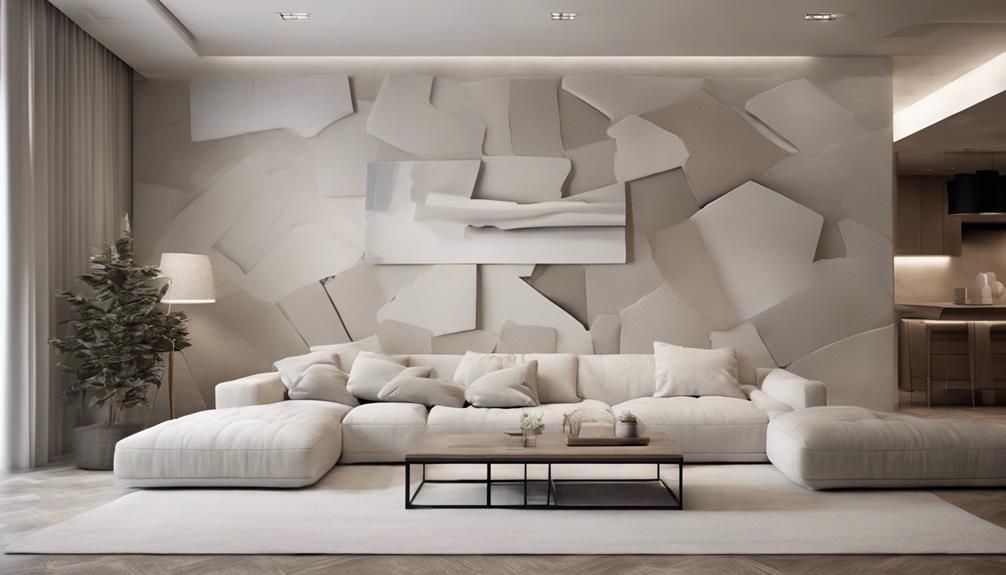
In exploring the aesthetic versatility of adobe walls, one can appreciate the myriad of creative possibilities they offer for designing distinctive interior spaces. Adobe walls can be molded and textured in various ways, allowing for the creation of unique and visually appealing designs that can become focal points in any room. From intricate patterns to sculptural elements, adobe walls add a touch of artistry to your living space, making it truly one-of-a-kind.
The natural earth tones of adobe walls further contribute to their aesthetic appeal by providing a warm and inviting atmosphere that enhances the overall look of your home. By finishing adobe walls with techniques like lime wash, earthen plasters, or natural pigments, you can achieve the desired aesthetic, whether it be rustic, modern, or traditional. This versatility makes adobe walls a perfect choice for complementing a wide range of interior design styles, allowing for endless possibilities in creating a space that reflects your unique taste and personality.
Frequently Asked Questions
What Are the Benefits of Adobe Walls?
We believe the benefits of adobe walls are exceptional. They provide outstanding thermal insulation, ensuring comfort year-round. Their fire-resistant nature enhances home safety.
With a lifespan lasting centuries, adobe walls are a durable and cost-effective choice. The natural materials create a healthy and eco-friendly living space.
What Makes Adobe Houses Unique?
Adobe houses stand out for their utilization of a mixture of clay, sand, and straw, setting them apart from conventional construction methods. The thick walls of adobe structures provide exceptional thermal mass, naturally regulating indoor temperatures.
This sustainable building technique, with its warm, earthy tones, adds character to a home. Throughout history, adobe construction has been a symbol of tradition and eco-conscious living.
It's no wonder adobe houses are a popular choice for those seeking unique, environmentally friendly homes.
Does Adobe Keep Your House Cool?
Yes, adobe keeps our house cool. The thermal mass properties of adobe walls absorb and store heat during the day, providing natural insulation and maintaining a stable indoor temperature.
This reduces the need for air conditioning, saving energy costs and creating a comfortable living environment.
The high thermal inertia of adobe contributes to a sustainable and eco-friendly home design, making it an excellent choice for those looking to stay cool in hot climates.
What Are the Benefits of Building With Adobe?
Building with adobe offers numerous benefits. Its thermal mass properties help regulate indoor temperatures, reducing the need for artificial heating or cooling.
Adobe is sustainable, with low processing requirements and a minimal carbon footprint. It promotes healthier living environments by balancing indoor humidity levels and providing low-toxicity spaces.
The unique aesthetic appeal of adobe blends well with natural surroundings and reflects local architectural styles. Adobe's composition ensures durability and environmental friendliness.
Conclusion
In conclusion, adobe walls offer a treasure trove of benefits for your home. Like a sturdy shield, they protect you from extreme temperatures, unwanted noise, and pesky pests.
Their eco-friendly nature and energy-saving properties make them a wise choice for sustainable living.
With their timeless charm and durability, adobe walls stand as a symbol of practicality and beauty, creating a cozy sanctuary that you can enjoy for years to come.
- About the Author
- Latest Posts
Introducing Ron, the home decor aficionado at ByRetreat, whose passion for creating beautiful and inviting spaces is at the heart of his work. With his deep knowledge of home decor and his innate sense of style, Ron brings a wealth of expertise and a keen eye for detail to the ByRetreat team.
Ron’s love for home decor goes beyond aesthetics; he understands that our surroundings play a significant role in our overall well-being and productivity. With this in mind, Ron is dedicated to transforming remote workspaces into havens of comfort, functionality, and beauty.
Architecture Home Styles
How to Explore Native Houses in Indonesia
Catch a glimpse of Indonesia's cultural treasures through native houses, where each intricate detail holds a secret waiting to be discovered.

So, you think you've seen it all in Indonesia? Well, think again. Exploring native houses in this diverse archipelago offers a glimpse into a world where tradition meets craftsmanship in a harmonious blend.
From the intricate carvings to the unique architectural designs, each house tells a story waiting to be uncovered, inviting us to step into a realm where time seems to stand still.
But what lies beyond the façade of these cultural gems is a journey that promises to unravel the tapestry of Indonesia's rich heritage, revealing a side often overlooked by many travelers.
Key Takeaways
- Visit Batak, Toraja, and Joglo Houses for diverse architectural experiences.
- Discover intricate carvings and symbolic details in traditional Indonesian homes.
- Immerse in cultural heritage through communal spaces and ancient craftsmanship.
- Learn about Indonesia's rich history and values by exploring native houses.
Traditional Houses in Indonesia
In Indonesia, traditional houses embody rich cultural heritage through their unique architectural designs and symbolism. Among these remarkable dwellings, the boat-shaped houses stand out for their distinctive characteristics. The Batak House, found in certain regions, showcases intricate carvings and utilizes natural materials, reflecting a deep connection to the environment. These boat-shaped structures not only serve as homes but also as symbols of cultural identity and traditions passed down through generations.
The boat-shaped design of these traditional houses in Indonesia not only provides shelter but also represents a deeper meaning within the community. The intricate carvings on the Batak House, for example, tell stories of ancestry and spiritual beliefs, adding layers of significance to the architectural aesthetics. Through these boat-shaped dwellings, the indigenous peoples of Indonesia honor their heritage and preserve their cultural roots in a rapidly changing world.
Cultural Significance of Indigenous Dwellings

Exploring the intricate cultural significances embedded within indigenous dwellings in Indonesia unveils a tapestry of architectural symbolism and traditional values that resonate deeply within the communities they inhabit. These houses serve as more than mere shelters; they embody the cultural beliefs and practices of the diverse Indonesian tribes. The multi-generational living arrangements seen in houses like the Rumah Gadang in West Sumatra and the Rong Houses in Dayak communities highlight the importance of family and community ties in Indonesian society.
Moreover, the communal living spaces found in the Tongkonan House in Tana Toraja and the Uma Lulik in Timor foster a sense of togetherness and shared responsibilities among the inhabitants. Each architectural element, from the intricate carvings to the circular shapes and elevated stilts, holds deep symbolic meaning rooted in centuries-old traditions. These indigenous dwellings aren't just physical structures but living embodiments of Indonesia's rich cultural heritage, where every beam and wall tells a story of cultural continuity and communal harmony.
Top Native Houses to Visit
With intricate architectural designs and rich cultural symbolism, a journey to explore the top native houses in Indonesia promises a captivating immersion into the country's diverse heritage. Here are some of the top native houses you shouldn't miss:
| Native House | Features |
|---|---|
| Batak Houses | Boat-shaped roofs, intricate carvings, spaces for daily life activities like a living room and dining room. |
| Toraja Houses | Distinct saddleback roof design, used in ceremonies, areas for daily life such as a living room and dining room. |
| Joglo Houses | Elaborate wooden structures, symbolizing social hierarchy, with designated spaces for a living room and dining room. |
These native houses offer insights into the daily lives of the people inhabiting them. From the communal spaces like the living room where gatherings take place to the dining room where meals are shared, each house reflects the cultural practices and traditions of its respective community. Exploring these spaces provides a unique opportunity to understand the interconnectedness between architecture, daily life, and cultural identity in Indonesia.
Exploring Architectural Features

Amidst the vibrant tapestry of Indonesia's architectural landscape, one encounters a rich mosaic of cultural intricacies within the native houses that stand as living testaments to the country's diverse heritage. As we delve into exploring the architectural features of these remarkable dwellings, we're greeted by a fusion of craftsmanship and symbolism that captivates the senses:
- Boat-shaped roofs that gracefully mimic the curves of traditional Indonesian vessels, offering a nod to the nation's maritime history.
- Intricate carvings adorning the facades and interiors, telling stories of myths, legends, and ancestral wisdom.
- Wooden craftsmanship that showcases the mastery of artisans, each piece meticulously crafted to perfection.
- Natural materials seamlessly integrated into the structures, connecting the homes to the earth and reflecting a harmonious relationship with nature.
- Symbolic details embedded in every corner, from the layout to the decorations, embodying cultural beliefs and societal values passed down through generations.
Exploring these architectural marvels unveils a world where history, artistry, and tradition converge in a celebration of Indonesia's rich cultural heritage.
Immersing in Indonesian Hospitality
Immerse yourself in the captivating tapestry of traditional Indonesian hospitality by residing in native houses like the Batak House in North Sumatra or the Rumah Gadang in West Sumatra. These native houses not only offer a place to stay but also provide a gateway to the cultural heritage of Indonesia. The intricate carvings, boat-shaped roofs, and eco-friendly construction of these houses showcase the deep-rooted traditions and craftsmanship of the local communities.
Here is a table highlighting some of the unique aspects of traditional Indonesian hospitality found in native houses:
| Aspect | Description |
|---|---|
| Architectural Features | Intricate carvings, boat-shaped roofs |
| Social Significance | Symbolism of social hierarchy in houses like the Joglo House in Central Java |
| Eco-Friendly Construction | Use of sustainable materials like bamboo and thatch in houses like the Sasak House in Lombok |
| Spiritual Connections | Preservation of spiritual connections and communal living traditions in houses like the Uma Lulik in Timor or the Honai House in Papua |
| Local Way of Life | Experience the daily lives and customs of the local communities while staying in these native houses |
Staying in these native houses will not only provide you with a unique accommodation experience but also a deep dive into the rich tapestry of Indonesian traditions and hospitality.
Frequently Asked Questions
What Are Traditional Indonesian Houses Called?
Traditional Indonesian houses are called 'Rumah Adat.' These structures are more than just dwellings; they're living representations of Indonesia's rich cultural tapestry. Crafted from natural materials like wood and thatch, they stand as testaments to the country's diverse traditions.
Each region boasts its own unique design, influenced by local customs and beliefs. Exploring these native houses allows us to delve into the heart of Indonesia's vibrant heritage and architectural ingenuity.
What Is Indonesian Housing Like?
Indonesian housing embodies a rich tapestry of cultures and traditions, showcasing unique architecture and sustainable practices. From boat-shaped roofs to intricate carvings, these homes reflect a deep connection to nature and community.
Families often live together in multi-story structures, fostering bonds and kinship. Sustainability and cultural symbolism intertwine in Indonesian homes, creating a harmonious blend of functionality and heritage preservation.
Each dwelling tells a story of tradition, innovation, and unity.
What Is Typical Indonesian Housing?
We'll dive into the essence of typical Indonesian housing, showcasing the diverse array of styles like Batak, Toraja, Joglo, and more. These houses boast unique architectural features, reflecting the rich heritage of Indonesia's indigenous communities.
From intricate carvings to bamboo and thatch construction, each house tells a story of cultural significance and tradition. Multi-generational living arrangements further deepen the bond between people, highlighting the social and spiritual connections within the community.
What Is a House Called in Indonesia?
In Indonesia, a house is often referred to as a 'rumah' in Bahasa Indonesia. These structures aren't merely places of dwelling; they embody the essence of Indonesian culture and heritage.
Each region has its unique names for traditional houses, such as 'rumah adat' or 'rumah suku,' showcasing the diverse architectural styles and craftsmanship.
These homes serve as living monuments, reflecting the country's history, beliefs, and social structure.
Conclusion
In conclusion, exploring native houses in Indonesia is like taking a journey through a living museum of cultural heritage. Each traditional dwelling tells a story of the past and present, showcasing the craftsmanship and traditions of its people.
By immersing ourselves in these architectural wonders, we can truly appreciate the beauty and diversity of Indonesia's indigenous cultures. So, let's hit the road and dive into the rich tapestry of Indonesian history – the world is our oyster!
- About the Author
- Latest Posts
Introducing Ron, the home decor aficionado at ByRetreat, whose passion for creating beautiful and inviting spaces is at the heart of his work. With his deep knowledge of home decor and his innate sense of style, Ron brings a wealth of expertise and a keen eye for detail to the ByRetreat team.
Ron’s love for home decor goes beyond aesthetics; he understands that our surroundings play a significant role in our overall well-being and productivity. With this in mind, Ron is dedicated to transforming remote workspaces into havens of comfort, functionality, and beauty.
Architecture Home Styles
How Do You Mix Modern and Traditional Art Styles?
Balancing the fusion of modern and traditional art styles in a space can be a captivating challenge – want to know the secret?

When it comes to blending modern and traditional art styles, finding the perfect equilibrium can seem like an insurmountable task. However, by carefully curating a space that seamlessly fuses the two, the results can be awe-inspiring.
But how exactly can this be achieved? Stay tuned as we unravel the intricacies of merging these seemingly contrasting artistic realms to create a harmonious and captivating environment that speaks to the essence of both styles.
Key Takeaways
- Blend colors, materials, and shapes for a cohesive look.
- Establish harmony through shared textures and patterns.
- Use common color palettes and subtle details for cohesion.
- Integrate traditional and modern art for a stylish, effortless design.
Dominant Style Selection
Upon evaluating the home shell and architecture, we determine the dominant style by applying the 80/20 rule, allocating 80% for the primary style and 20% for the secondary style. To achieve a harmonious blend of modern and traditional design, we strategically place traditional pieces as the foundation, anchoring the space with their timeless elegance. Modern art with retro undertones can then be incorporated to infuse a touch of innovation and vitality. By integrating contemporary finds alongside vintage furniture, we create an eclectic yet cohesive overall look that seamlessly marries the two design styles.
Selecting the dominant style is crucial, as it sets the tone for the entire space. By opting for a mix of modern and traditional elements, we can strike a balance that's both refreshing and sophisticated. The key lies in seamlessly blending the two styles to create a visually stimulating environment that captivates the eye and sparks curiosity. When done thoughtfully, the fusion of modern and traditional design can result in a space that isn't only aesthetically pleasing but also rich in character and depth.
Harmony Vs. Contrast

After establishing the dominant style selection in a space blending modern and traditional art styles, the next crucial consideration is determining whether to prioritize harmony or contrast in the overall design approach. When mixing modern and traditional elements, the choice between harmony and contrast plays a significant role in the visual impact of the room.
| Harmony | Contrast |
|---|---|
| Evenly distribute elements from both styles | Use colors and materials to blend or contrast styles |
| Create a cohesive look | Achieve a bold and dynamic effect |
| Balance furniture choices for a calming harmony | Opt for striking contrasts to reflect personal style |
To achieve harmony, blend colors and materials seamlessly, integrating modern and traditional pieces throughout the room. Contrast, on the other hand, can be achieved by strategically placing items that diverge in style, color, or era. Whether aiming for a contemporary feel or a touch of vintage charm, the decision between harmony and contrast will define the overall aesthetic of the space.
Starting With Essential Pieces
We start the design process by focusing on selecting essential furniture pieces that will serve as the foundation for blending modern and traditional art styles in the room. It's crucial to establish a strong base with key elements such as traditional seating arrangements or larger units before introducing modern art pieces or contemporary furniture.
Sofas and tables play a vital role in setting the tone for the space, providing a canvas for layering different styles. When deciding on chairs, strategic placement can add personality and elevate the overall design. Narrowing down furniture choices based on the dominating style helps in determining whether to aim for harmony or contrast when mixing modern and traditional elements.
Tying Art Pieces Together

To achieve a cohesive blend of modern and traditional art styles in a space, the key lies in tying art pieces together through shared colors, shapes, textures, or patterns. When merging different art styles, it's essential to create visual harmony by incorporating common elements that bridge the gap between traditional and modern aesthetics.
Here are five strategies to unify art pieces effectively:
- Utilize a similar color palette: Using shared colors across traditional and modern artworks can create a cohesive appearance and tie the pieces together seamlessly.
- Focus on common shapes: Look for recurring shapes or forms in the art pieces to establish a visual connection and blend the styles cohesively.
- Consider shared textures: Incorporating similar textures in both traditional and modern art can enhance the overall visual cohesion of the space.
- Highlight recurring patterns: Identifying and emphasizing common patterns in the artworks can help unify them and create a harmonious look.
- Pay attention to subtle details: Small details in art pieces can play a significant role in blending traditional and modern styles, so focusing on these nuances is key to achieving a cohesive design.
Adding Final Touches
Incorporating strategic elements like velvet throw pillows and thoughtful lighting choices plays a crucial role in enhancing the fusion of modern and traditional art styles within a space. These final touches serve as the bridge that connects the two worlds, creating rooms that appear effortless and stylish. By mixing traditional and modern aesthetics with a neutral color palette, you can achieve a harmonious balance that's visually appealing.
When adding final touches, consider integrating a vintage piece of art alongside contemporary curves to add depth and character to the room. This juxtaposition of styles creates an eclectic atmosphere that's both intriguing and inviting. Combining modern and traditional styles in this manner allows for a seamless transition between the two, resulting in a space that feels cohesive and well-thought-out.
To master the art of mixing traditional and modern art styles, focus on layering textures, incorporating unexpected elements, and paying attention to the finer details. By following these design tips, you can transform your space into a great place to start experimenting with the fusion of vintage and contemporary art, ultimately achieving a look that's both timeless and fresh.
Frequently Asked Questions
Can You Mix Modern and Traditional Styles?
Yes, we can seamlessly blend modern and traditional styles to create a captivating fusion. By intertwining contemporary elements with classic artistry, we achieve a design that's both timeless and cutting-edge.
This harmonious marriage of old and new offers a fresh perspective and cultivates a rich visual tapestry. Embracing the juxtaposition of modern and traditional styles leads to an innovative approach that sparks creativity and intrigue in interior design.
How Do You Blend Traditional and Modern?
When blending traditional and modern art styles, we aim for a seamless integration that harmonizes the contrasting aesthetics. Finding commonalities in colors, shapes, and textures between the two styles is key.
What Is the Combination of Traditional and Modern Design Called?
The combination of traditional and modern design is known as 'Transitional' style. This aesthetic blends classic elements with contemporary features, creating a balanced and harmonious look.
It seamlessly integrates traditional and modern art pieces, offering a timeless and cohesive space. Transitional design emphasizes comfort, warmth, and simplicity with clean lines and a minimalistic approach.
It aims to merge elements from different eras to achieve a cohesive and innovative design.
How Do You Combine Different Art Styles?
When combining different art styles, we focus on harmony and contrast. By blending complementary colors and themes and experimenting with various mediums, we create a cohesive yet dynamic visual experience.
Symmetry and asymmetry play a crucial role in adding balance and interest to our art arrangements. Dominant styles serve as focal points, while contrasting ones add depth and dimension.
Ultimately, our goal is to personalize spaces and evoke a sense of creativity and innovation.
Conclusion
In conclusion, blending modern and traditional art styles is a delicate dance of balance and creativity. By carefully selecting a dominant style, harmonizing or contrasting elements, and layering essential pieces with unique art, textiles, lighting, and plants, a space can truly come to life.
Embracing imperfections and experimenting with unexpected themes adds depth and personality to the mix. The result? A visually captivating and harmonious fusion of the old and the new.
- About the Author
- Latest Posts
Introducing Ron, the home decor aficionado at ByRetreat, whose passion for creating beautiful and inviting spaces is at the heart of his work. With his deep knowledge of home decor and his innate sense of style, Ron brings a wealth of expertise and a keen eye for detail to the ByRetreat team.
Ron’s love for home decor goes beyond aesthetics; he understands that our surroundings play a significant role in our overall well-being and productivity. With this in mind, Ron is dedicated to transforming remote workspaces into havens of comfort, functionality, and beauty.
Architecture Home Styles
How to Have a Tiny Home in Arizona: Your Essential Guide
Fascinated by the idea of a tiny home in Arizona? Discover how tax considerations can impact your journey in this essential guide.
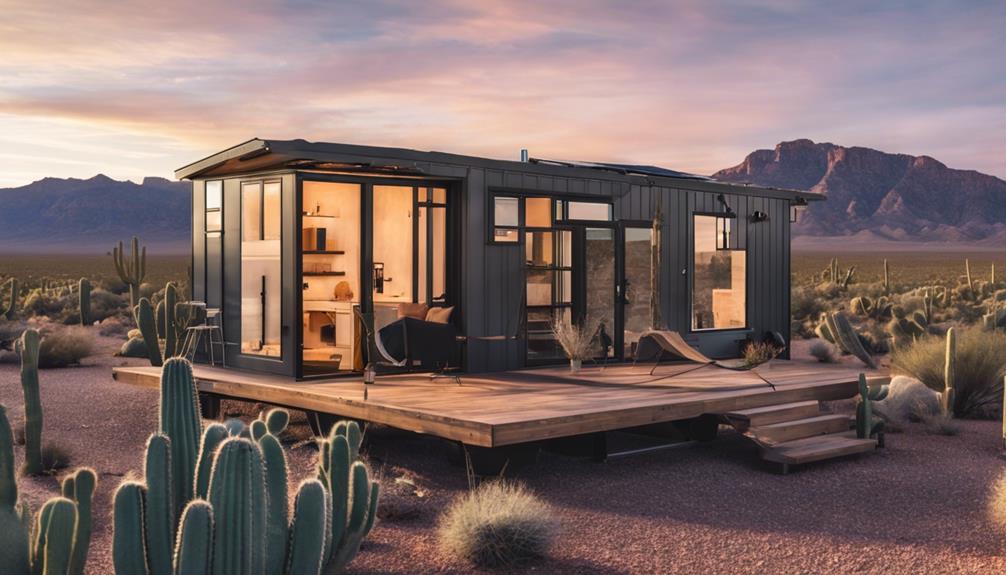
Embarking on the journey of having a tiny home in Arizona is like navigating through a desert oasis, each step revealing new insights and challenges. From understanding the intricate web of zoning laws to discovering the perfect location that aligns with your tiny living dreams, this essential guide equips you with the knowledge needed to turn your tiny home vision into reality.
But what about the unique tax considerations that come with owning a tiny home in Arizona? Stay tuned to uncover key insights that will make a difference in your tiny home journey.
Key Takeaways
- Understand Arizona zoning laws for placement in suitable zones.
- Seek permits for tiny homes based on location and structure type.
- Explore tax benefits for tiny homeowners through property tax exemptions.
- Build a supportive community through local groups and events for guidance.
Zoning Laws and Regulations in Arizona
When navigating the realm of tiny home living in Arizona, understanding the intricacies of zoning laws and regulations becomes paramount. In Arizona, zoning laws permit tiny houses on foundations in multifamily, detached single-family, and accessory dwelling unit zones.
However, for Tiny Homes on Wheels, they're typically classified as recreational vehicles and must adhere to specific parking regulations within designated zones. Maricopa County has established particular regulations for tiny houses, including constraints on the floor area allowed for permanent structures. On the other hand, Pima County imposes restrictions on Tiny Homes on Wheels through specific codes that govern their placement.
The zoning options for tiny houses in Arizona encompass various zones such as isolated single-family zones, accessory dwelling unit zones, and multifamily zones. Familiarizing oneself with these zoning laws and regulations is crucial for anyone considering embarking on the adventure of tiny home living in Arizona.
Ideal Locations for Tiny Homes
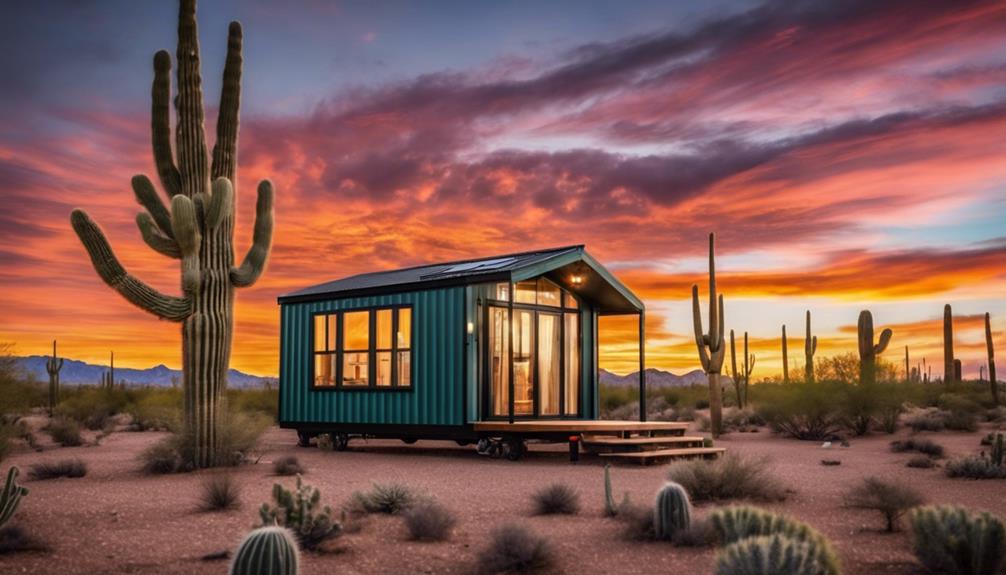
For those seeking ideal locations to establish their tiny homes in Arizona, cities like Phoenix, Tucson, Sedona, and Lakeside present attractive options. When considering where to set up your tiny home in Arizona, keep in mind that Pima County and Coconino County permit the establishment of tiny houses in specific zones. In these areas, tiny homes can be placed in isolated single-family zones, ADU zones, and multifamily zones. For those with tiny houses on wheels, it's important to note that they must be parked in designated R.V. zones in compliance with regulations.
- Phoenix, Tucson, Sedona, and Lakeside are ideal cities for setting up tiny homes in Arizona.
- Pima County and Coconino County allow tiny houses in specific zones.
- Tiny homes can be placed in single-family zones, ADU zones, and multifamily zones.
- Tiny houses on wheels must adhere to regulations in designated R.V. zones.
Tax Considerations for Tiny Home Owners
Exploring the tax implications of owning a tiny home in Arizona reveals potential benefits and considerations that can significantly impact financial planning for homeowners. Tiny home owners in Arizona may qualify for property tax exemptions based on factors like square footage and adherence to green building standards. Additionally, the size of tiny homes could lead to reduced property tax assessments in certain counties. It is crucial for Arizona tiny home owners to familiarize themselves with local tax laws to take advantage of any available tax benefits. Seeking guidance from a tax professional or local tax assessor can provide valuable insights into how owning a tiny home in Arizona may influence property taxes.
Tax Considerations for Tiny Home Owners:
| Key Points | Details | Importance |
|---|---|---|
| Property Tax Exemptions | Available based on square footage and green standards | Maximize Savings |
| Reduced Assessments | Smaller homes could mean lower tax bills | Financial Advantage |
| County Variances | Regulations differ, impacting tax benefits | Local Compliance |
| Professional Advice | Consult with tax professionals for guidance | Optimal Planning |
Finding Community Support in Arizona

By actively engaging with local resources and networking opportunities, tiny home enthusiasts in Arizona can establish a strong sense of community support to enhance their living experience.
Here are some ways to find community support in Arizona:
- Join local Facebook groups like 'Arizona Tiny House Community' for a supportive network.
- Attend tiny house meetups and events in Arizona to connect with like-minded individuals.
- Explore tiny house workshops and seminars in the state to gain knowledge and resources.
- Consider volunteering with non-profit organizations focused on sustainable living and tiny house advocacy in Arizona.
These opportunities not only provide a sense of belonging within the tiny house community but also offer valuable insights, resources, and support for those embracing the tiny home lifestyle in Arizona.
Engaging with these avenues can enrich your experience, foster connections, and empower you to navigate the challenges and joys of sustainable living in the state.
Building and Parking Tips for Tiny Homes
Engaging with the regulations and guidelines for building and parking tiny homes in Arizona is crucial for ensuring compliance and a smooth transition into sustainable living. Tiny homes on foundations in Arizona must adhere to the 2018 IRC Appendix Q requirements, which outline specific space dimensions and safety features to guarantee structural integrity.
Building a tiny home on skids offers a semi-permanent placement option while still allowing for mobility if relocation becomes necessary. For those opting for tiny homes on wheels, meeting mobile home requirements is essential, and a minimum of 160 square feet is required for parking.
The flexibility in setting up tiny homes in various zone types in Arizona provides diverse housing options based on individual preferences. Tiny houses on wheels are particularly popular for their mobility and flexibility, making them an attractive choice for those desiring a minimalist lifestyle without sacrificing comfort.
Frequently Asked Questions
Can I Put a Tiny House on My Property in Arizona?
Yes, we can put a tiny house on our property in Arizona if it complies with local zoning regulations. Different options like multifamily, detached single-family, or accessory dwelling units are available. Land near Maricopa City, Pinal County, offers accessible placement.
How Much Does a Tiny House Cost in Az?
Tiny houses in Arizona can range from $20,000 to $200,000 depending on size and customization. DIY kits start at $8,000, but labor costs add up. Land, utilities, and permits are extra. Building a tiny house can be a cost-effective housing choice.
What Is the Minimum Square Footage for a House in Arizona?
In Arizona, the minimum square footage for a house varies based on its foundation type. For tiny houses on foundations, it's 200 square feet, while those on trailers require at least 160 square feet. Adhering to building codes is essential.
Does Arizona Have a Tiny Home Community?
We do have tiny home communities in Arizona. These communities provide shared amenities, community engagement, and a supportive environment. Living in a tiny house community offers a unique sense of belonging, shared resources, and a close-knit experience.
Conclusion
In conclusion, navigating the world of tiny homes in Arizona may seem like a daunting task, but with the right resources and community support, it can be a breeze.
From zoning laws to building tips, we've covered it all in our essential guide.
So go ahead, take the leap into tiny home living and watch your dreams of a cozy, sustainable lifestyle come to life in the Grand Canyon State!
- About the Author
- Latest Posts
Introducing Ron, the home decor aficionado at ByRetreat, whose passion for creating beautiful and inviting spaces is at the heart of his work. With his deep knowledge of home decor and his innate sense of style, Ron brings a wealth of expertise and a keen eye for detail to the ByRetreat team.
Ron’s love for home decor goes beyond aesthetics; he understands that our surroundings play a significant role in our overall well-being and productivity. With this in mind, Ron is dedicated to transforming remote workspaces into havens of comfort, functionality, and beauty.
-

 Vetted3 weeks ago
Vetted3 weeks ago15 Best Poe Cameras for Home Security – Reviews & Buying Guide
-

 Vetted17 hours ago
Vetted17 hours ago15 Best Gravel for Driveway: The Ultimate Guide for a Durable and Stunning Entrance
-

 Beginners Guides2 weeks ago
Beginners Guides2 weeks agoI Inhaled Vinegar Fumes
-

 Beginners Guides3 weeks ago
Beginners Guides3 weeks agoSwinger Porch Light Color
-

 Vetted3 days ago
Vetted3 days ago15 Best Hot Tubs of 2024: Luxurious Relaxation at Your Fingertips
-

 Vetted3 weeks ago
Vetted3 weeks ago15 Best Blinds for Bathroom Windows to Enhance Privacy and Style
-
![Best Ceiling Fans for Cathedral Ceilings: Top 12 Picks for Optimal Airflow and Style [2024] 142 61IOg5xQhlL](https://byretreat.com/wp-content/uploads/2023/11/61IOg5xQhlL-400x240.jpg)
![Best Ceiling Fans for Cathedral Ceilings: Top 12 Picks for Optimal Airflow and Style [2024] 143 61IOg5xQhlL](https://byretreat.com/wp-content/uploads/2023/11/61IOg5xQhlL-80x80.jpg) Vetted5 days ago
Vetted5 days agoBest Ceiling Fans for Cathedral Ceilings: Top 12 Picks for Optimal Airflow and Style [2024]
-

 Beginners Guides2 weeks ago
Beginners Guides2 weeks agoPros and Cons of Having a Creek on Your Property








![Best Christmas Albums of All Time [2024] 96 81wYV4USGL](https://byretreat.com/wp-content/uploads/2023/11/81wYV4USGL-80x80.jpg)

![Best Electric Tea Kettle for Quick and Efficient Brewing [2024] 98 61rla59uCL](https://byretreat.com/wp-content/uploads/2023/11/61rla59uCL-80x80.jpg)







![Best Christmas Albums of All Time [2024] 123 81wYV4USGL](https://byretreat.com/wp-content/uploads/2023/11/81wYV4USGL-400x240.jpg)


![Best Gun Mat: Protect Your Firearm and Workstation [2024] 129 61gn7N19CL](https://byretreat.com/wp-content/uploads/2023/11/61gn7N19CL-80x80.jpg)